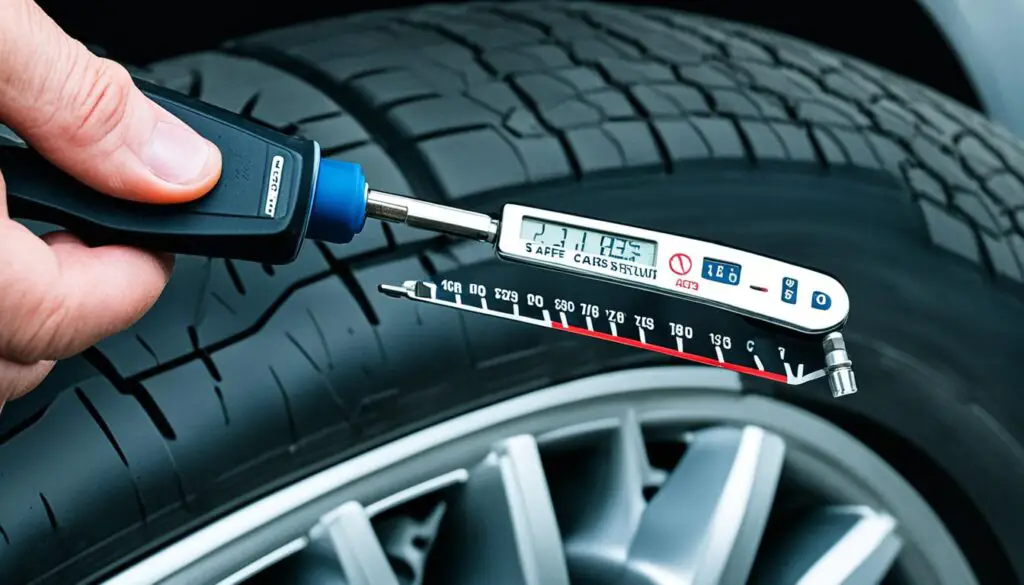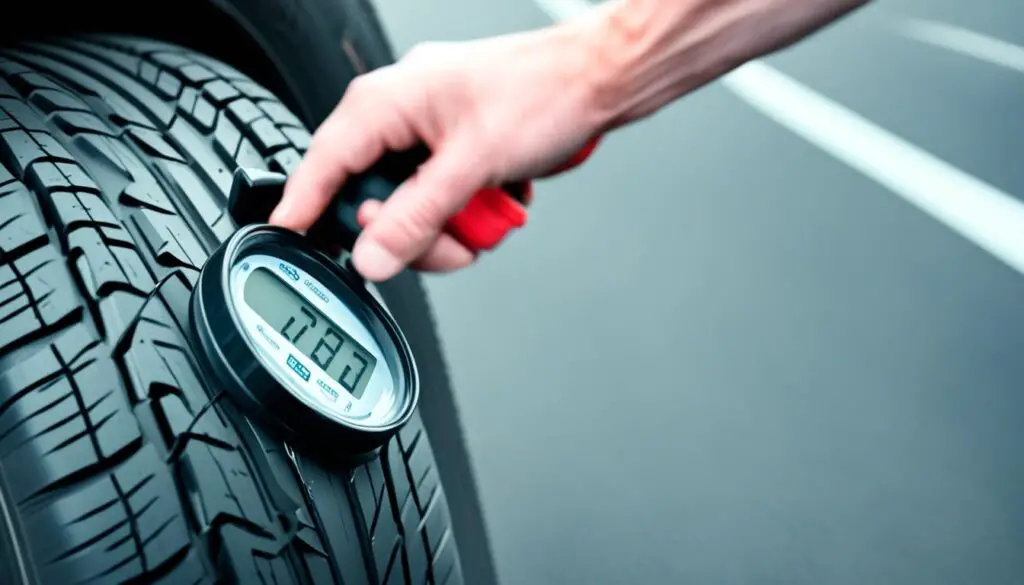
Tire Safety: Essential Checks for Every Driver
As a responsible driver, I understand the importance of prioritizing tire safety on the road. Neglecting proper tire maintenance can lead to hazardous situations and put both myself and others at risk. That’s why I make it a point to regularly perform essential checks to ensure my tires are in optimal condition.
When it comes to tire safety, there are three key areas that every driver should focus on: tire pressure, tread depth, and overall tire condition. By paying attention to these aspects and conducting regular checks, I can greatly reduce the risk of accidents and enjoy safer travels.
Key Takeaways:
- Regularly check your tire pressure to ensure it is within the recommended range for optimal vehicle performance and safety.
- Inspect the tread depth of your tires using a tread depth gauge or the penny test, and replace them if they are too worn down.
- Maintain the overall condition of your tires by checking for any signs of damage, such as cuts, bulges, or punctures.
- Keep your tires clean and free from debris to prevent any foreign objects from affecting their performance.
- By prioritizing tire safety and conducting these essential checks, you can significantly reduce the chances of tire-related incidents and ensure a more secure journey.
Importance of Regular Tire Pressure Checks
One of the most crucial aspects of tire safety is maintaining proper tire pressure. As an experienced driver, I understand the significance of regularly checking tire pressure and ensuring it remains within the recommended range. Not only does it contribute to optimal tire performance, but it also plays a vital role in overall vehicle safety.
Driving with underinflated or overinflated tires can have serious consequences on vehicle performance and safety. Let’s take a closer look at the implications of both scenarios:
- Underinflated tires: Driving with inadequate tire pressure can lead to various issues such as reduced fuel efficiency, increased tire wear, and compromised handling and braking capabilities. In fact, studies have shown that underinflated tires can increase fuel consumption by up to 3%. Additionally, tires that are not properly inflated have a higher chance of overheating, which can result in a blowout while driving.
- Overinflated tires: On the other hand, overinflated tires can also pose significant risks. Too much air pressure can lead to a harsher ride, diminished comfort, and decreased traction. Furthermore, overinflated tires are more prone to blowouts, especially when driving over rough surfaces or encountering potholes.
By conducting regular tire pressure checks and maintaining the recommended level, I can ensure optimal tire performance and enhance overall safety on the road.
“Maintaining regular tire pressure checks is crucial for optimal tire performance and vehicle safety.”
To further emphasize the importance of regular tire pressure checks, here is a table summarizing the potential consequences of driving with underinflated and overinflated tires:
| Tire Condition | Potential Issues |
|---|---|
| Underinflated |
|
| Overinflated |
|
I strive to prioritize tire safety by conducting regular checks on tire pressure. By doing so, I can maintain optimal tire performance, improve fuel efficiency, and most importantly, ensure a safer driving experience for myself and others on the road.

The Significance of Checking Tread Depth
When it comes to tire safety, one crucial aspect that often goes unnoticed is checking the tread depth. The tread on tires plays a vital role in providing traction and grip on the road surface, especially during wet or slippery conditions. Over time, however, the tread gradually wears down, diminishing its effectiveness and compromising the tire’s ability to maintain traction.
In order to ensure optimal grip and safety on the road, it is recommended to regularly check the tread depth of your tires. By measuring the depth, you can determine whether the tires still have sufficient tread to provide adequate traction. There are two common methods for checking tread depth: using a tread depth gauge or performing the penny test.
Using a Tread Depth Gauge
A tread depth gauge is a tool specifically designed to accurately measure the depth of tire treads. It allows you to obtain precise measurements and determine whether the tread depth meets the minimum requirement for safe driving. By using a tread depth gauge, you can easily identify when it’s time to replace your tires and maintain optimal safety on the road.
The Penny Test
The penny test is a simple yet effective method that can be used to check tread depth without any specialized tools. All you need is a penny and a few seconds of your time. Insert the penny into the tire’s tread with Lincoln’s head facing downward. If you can see Lincoln’s entire head, this indicates that the tread depth is too low, and it’s time to replace your tires for improved safety.
Checking tread depth is of utmost significance for your safety on the road. Without adequate tread depth, your tires may have reduced traction, compromising your ability to brake, handle, and maintain control of your vehicle. Ensuring proper tread depth will provide you with peace of mind and help prevent accidents caused by insufficient grip on the road.
| Tread Depth | Condition |
|---|---|
| 9/32 inch or more | Excellent tread depth |
| 6/32 inch | Average tread depth |
| 4/32 inch | Borderline tread depth |
| 2/32 inch or less | Unsafe tread depth, replace tires |
Referencing the table above can provide you with a better understanding of how different tread depths affect tire safety. It’s important to note that experts recommend replacing tires when the tread depth reaches 4/32 inch or less to ensure optimal performance and safety on the road.
Remember, checking tread depth is not just about compliance; it’s about your safety and the safety of those around you. Regularly inspecting your tires and replacing them when necessary will help you maintain proper braking, handling, and overall road safety.
Maintaining Overall Tire Condition
In addition to tire pressure and tread depth, it is crucial to prioritize the overall condition of your tires. Regular maintenance and inspections are essential to ensure optimal tire performance and safety on the road.
One of the key aspects of maintaining overall tire condition is checking for signs of damage. Cuts, bulges, or punctures can weaken the structure of the tire and increase the risk of a blowout or loss of control while driving. By inspecting your tires regularly, you can identify and address any issues promptly.
It is also important to keep your tires clean and free from debris. Foreign objects lodged in the tire tread can affect the tire’s performance and compromise safety. Regularly removing any debris from your tires will help maintain their optimal grip and traction on the road.

Remember, maintaining overall tire condition is a crucial part of tire safety and longevity. By regularly inspecting your tires for damage and keeping them clean, you can ensure a safer and more comfortable driving experience.
Conclusion
In conclusion, tire safety is of utmost importance for every driver. It is crucial to conduct regular checks on tire pressure, tread depth, and overall tire condition to ensure optimal performance and safer journeys. Neglecting these essential checks can lead to increased risks of accidents, compromised vehicle handling, and reduced fuel efficiency.
By prioritizing tire safety and giving proper attention to tire maintenance, drivers can significantly minimize the chances of tire-related incidents and enjoy a more secure travel experience. Regularly monitoring tire pressure, checking tread depth, and inspecting for any signs of damage are key practices in maintaining tire safety.
Remember, tire safety is not just about following regulations, but also about ensuring the well-being of yourself, your passengers, and other road users. By taking these essential checks seriously, you demonstrate responsible driving and contribute to a safer road environment for everyone. So, be proactive and make tire safety a non-negotiable part of your routine as a conscientious driver.
FAQ
Why is tire safety important?
Tire safety is important because neglecting proper tire maintenance can lead to hazardous situations on the road. By prioritizing tire safety and performing regular checks, drivers can greatly reduce the risk of accidents and ensure safer travels.
What is the significance of regular tire pressure checks?
Regular tire pressure checks are crucial for maintaining optimal tire performance and overall safety on the road. Driving with underinflated or overinflated tires can significantly affect vehicle performance, fuel efficiency, handling, and braking. By regularly checking tire pressure and ensuring it is within the recommended range, drivers can ensure safer travels.
Why is checking tread depth important?
Checking tread depth is important because the tread on tires provides traction and grip on the road surface. Over time, the tread gradually wears down, which can affect the tire’s ability to maintain traction, especially on wet or slippery roads. Adequate tread depth is crucial for proper braking, handling, and overall road safety.
Why is maintaining overall tire condition important?
Maintaining overall tire condition is important because a damaged tire can easily lead to a blowout or loss of control while driving. Regularly inspecting the tires for any signs of damage, such as cuts, bulges, or punctures, and addressing any issues promptly is essential for tire safety. Keeping the tires clean and free from debris is also important for optimal tire performance and safety.
